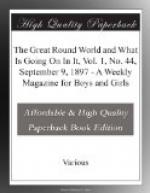The “mound-builders” have been busy all over the world. There is no flat country on any part of the earth where these strange monuments have not been found, singly or in groups, and it taxes at times a sharp eye to know them from the natural grass-grown knolls or hillocks on a so-called rolling plain, for which, indeed, they were taken until some accident made known what they really were.
Let us look at the interior of one of the most royal among these palaces of death—or, rather, in the builders’ minds, vestibules of a renewed life.
In the middle—or toward one end—of a large, rather low chamber, flagged and cased with stone masonry, lies the chieftain’s skeleton, with golden armlets and necklet, possibly a golden band encircling the skull, and some choice weapons by his side, within reach of the hand. Not infrequently tatters of some tissue show where the mantle was folded around the form; but that falls to dust at the lightest touch, and, indeed, at a longer contact with air, as do sometimes the bones themselves. A smaller skeleton—a woman’s—likewise adorned, shares the honors of the gloomy abode. It is the wife, or perchance the favorite wife, polygamy (the custom of having many wives) having long been universal. In a circle around the two principal figures, but at a respectful distance, indicating their subordinate station, are disposed other skeletons, unclothed and unadorned, evidently slaves, probably favorite attendants. Not infrequently a horse is found in a corner—the chief’s own charger; and even sometimes a dog at the master’s feet. Every skull, of man, woman, or animal, shows the heavy single blow which severed life. Not without due state and seemly retinue shall the hero enter on the new life which awaits him; his own best-loved companion shall minister to him; his own tried servants shall follow him as of yore; the steed which bore him safely out of many a battle, the hound which shared with him the joys of many a glorious chase, shall bear him into the fray with new and unknown foes, shall hunt down with him the game that roams the forests of the Unknown Land. As the way thither may be very long, the travellers shall not go unprovided. So around the wall are ranged dishes, platters, bowls—each containing dried-up food, various kinds of grains; also jars and tall vessels with handles, which evidently had held liquids. It is easy to see that the choicest pieces of fine and artistically ornamented pottery have been selected from the household stores. In mounds of the later periods some of the dishes and bowls are of bronze, even of gold and silver, and show considerable beauty of form and workmanship; but the jars are invariably of earthenware, as water and wine keep better in such than in metal.
We must not forget that, among the countless mounds which have been opened, only a very few are like that we just looked into. The general run are much plainer, and the majority contain only one silent inmate. It was not every one could afford the luxury of a wholesale slaughter in his household. The chambers, too, are very different in size and construction, and the furnishings vary quite as much in richness and beauty.




